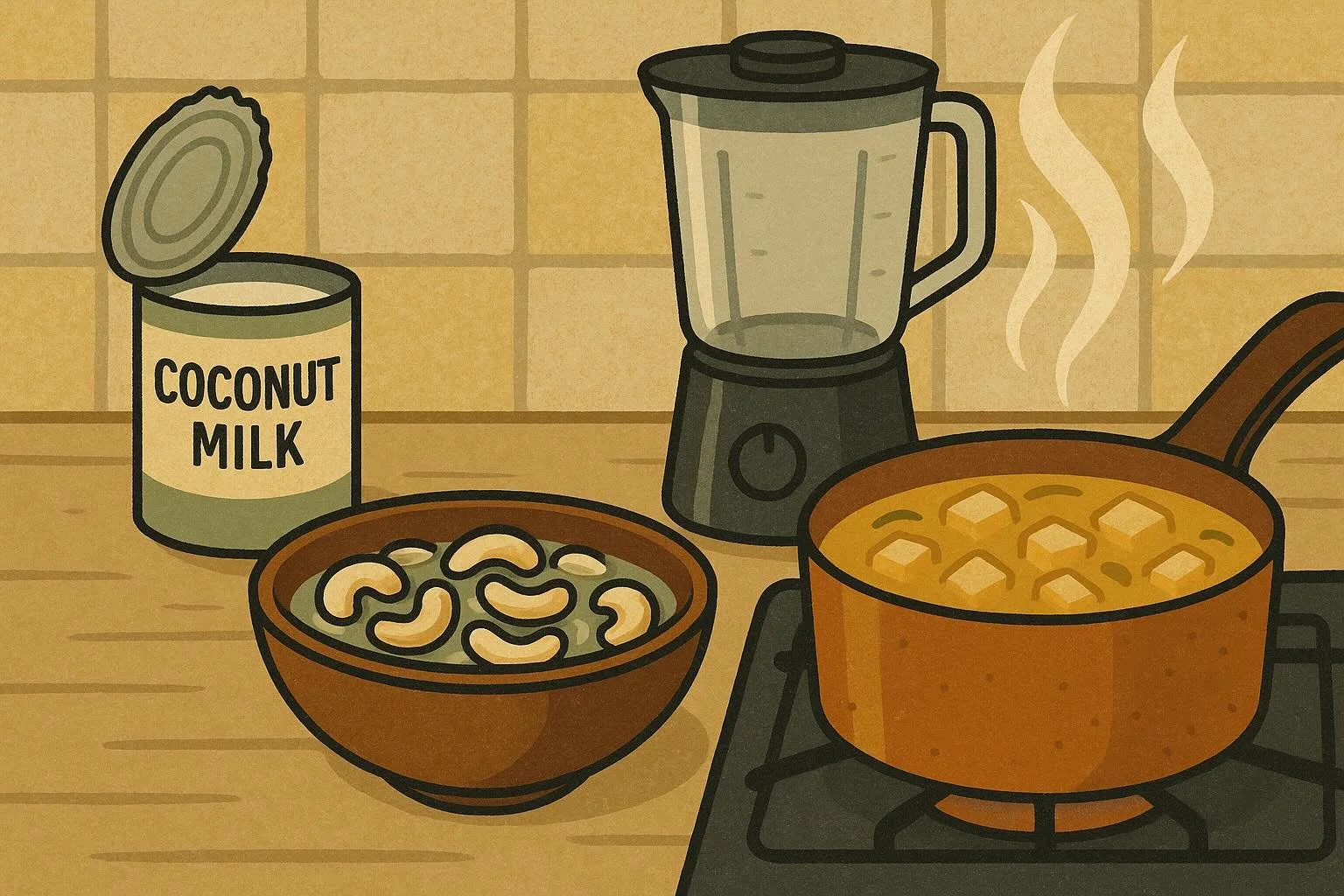Plant-Based Creaminess: Coconut and Cashews Explained
Creaminess is comfort. It’s the lush spoon-coating texture that transforms a simple dish into something memorable. In plant-based cooking, coconut and cashews have become go-to ingredients for creating that satisfying richness, each in their own unique way.
They’re not just dairy substitutes. They carry cultural legacies, offer culinary versatility, and—when you understand the science behind them—deliver results that feel indulgent and deeply nourishing.
Let’s explore how they work, where they shine, and how to use them consciously and confidently.
🥥 Coconut: Fat-Rich, Tropical, and Bold
What it is:
Coconut milk is an emulsion of blended coconut flesh and water, typically 17–24% fat.
Coconut cream is even richer, with ≥20% fat and a thick, spoon-coating consistency. Some canned varieties reach up to 35% fat.
Coconut oil is pure fat extracted from coconut meat.
Virgin coconut oil has a strong aroma and a lower smoke point (~177°C).
Refined coconut oil is neutral in flavour and has a higher smoke point (~204–232°C).
Desiccated coconut is finely grated and dried (ideal for baking).
Shredded coconut is moister and coarser (often used in sweets).
Why it works:
Coconut is rich in saturated fats, especially lauric acid, which melts around 24–26°C—just below body temperature. These fats stay solid at room temperature but melt smoothly in your mouth, giving that signature silky feel.
This fat structure also makes coconut milk and cream stable in hot dishes like curries and stews. However, the natural emulsion can break under high heat or acidity, especially in lower-fat or additive-free varieties.
Pro Tip: For sauces and soups, use full-fat canned coconut milk or cream (not beverage cartons), heat gently, and whisk continuously to prevent splitting.
Health Note: Coconut’s richness comes from saturated fat—similar to butter. While fine in moderation, especially in a plant-based diet, those mindful of heart health should enjoy it thoughtfully.
Best Uses:
Curries, stews, and soups (e.g. Thai green curry)
Vegan whipped cream (chill the can, use the thick top layer)
Coconut rice pudding or ganache
Rich sauces and frostings
Flavour Note: Coconut adds a subtle sweetness and tropical aroma—perfect for bold dishes but may dominate subtle recipes. Use cashew cream when a neutral base is preferred.
🌰 Cashews: Smooth, Neutral, and Transformative
What it is:
Cashews are kidney-shaped seeds (commonly called nuts) high in unsaturated fats (especially oleic acid), protein, and starch—a rare trio among nuts. When soaked and blended, they become one of the creamiest dairy-free bases.
Use raw, unsalted cashews (not roasted) for best results. What’s sold as "raw" has been heat-treated to remove toxic shell liquid (CNSL), making it safe to eat.
Why it works:
Cashews contain:
Fat for mouthfeel
Protein to stabilise emulsions
Starch for the body and thickening
Together, they create a smooth, stable blend that doesn’t split when heated. High-speed blending breaks particles into fine suspension, resulting in a silky, spoon-coating texture.
Blender Tip: If using a standard blender, soak longer (overnight if possible), blend in batches, and scrape down the sides. You can strain the cream through a fine mesh sieve for extra smoothness.
Pro Tip: Drain and rinse soaked cashews before blending to remove bitterness or residue.
Best Uses:
Alfredo or creamy pasta sauces
Vegan cheesecake, mousse, or ice cream
Creamy soups or chowders
Dressings, dips, or vegan sour cream
Allergen Warning ⚠️ Cashews are a common tree nut allergen and can cause severe reactions including anaphylaxis. Cross-reactivity with pistachios is common, and occasionally with pink peppercorns. Label dishes clearly and check before serving.
🧪 Why It Works: The Science of Plant-Based Fats
Creaminess is more than just fat—it’s about structure.
Fat molecules coat the tongue and carry flavour.
Saturated fats like those in coconut melt cleanly, creating a lush mouthfeel.
Cashew blends use starch and protein to suspend water and hold emulsions.
This is why coconut cream feels rich and melting, while cashew cream feels thick, smooth, and long-lingering.
🔧 Everyday Creaminess – Quick Guide
🥥 Thai curry? Stir in coconut milk for bold richness.
🌰 Creamy pasta? Blend soaked cashews into Alfredo.
💡 Fusion tip: Mix both for a vegan butter sauce.
🔥 Quick soak: 20 min in boiling water (or 4–6 hrs cold).
📦 Shelf life:
Cashew cream: ~4–5 days (fridge), can be frozen in ice cube trays for extended use.
Opened coconut milk: ~3–4 days (fridge). Shake/stir well before using.
🌏 Culture, Care, and Conscious Choices
These ingredients aren’t hacks—they’re traditions. Coconut and cashew-based creams have been central to cuisines from India, Sri Lanka, the Philippines, and beyond for centuries. They’re not replacements. They’re originals.
But they also come with responsibility:
Cashew shelling can expose workers to CNSL burns if not properly protected.
Some coconut farms, particularly in Thailand, have faced scrutiny for forced monkey labour.
Choose certified fair-trade, worker-safe, or monkey-free labels to ensure ethical sourcing. Look for certifications like Fairtrade, Rainforest Alliance, or GAP Monkey Free Plus.
Sustainability note: Cashew and coconut production typically has a lower carbon footprint than dairy cream. Still, sourcing from responsible farms helps minimise ecological impact.
💖 Creaminess Without Compromise
These aren’t just substitutes for dairy—they’re an expansion of what creaminess can be. Rooted in tradition. Backed by science. Made with compassion.
Whether you’re here for flavour, ethics, or curiosity, coconut and cashew creams can nourish you—and the world around you.
Creaminess isn’t a loss in plant-based cooking. It’s a rediscovery.
✅ Quick Recap – Your Creamy Kitchen Cheat Sheet
Coconut cream: ≥20% fat, rich and thick. Great for curries, whipped toppings, and bold sauces. Tropical flavour.
Cashew cream: Blend 1 cup soaked cashews + ¾ cup water. Neutral, smooth, versatile in pastas, soups, and dips.
Avoid splitting: Use full-fat coconut, heat gently, whisk often.
Allergens: Cashews (common), pistachios (cross-reactive). Coconut rarely triggers allergies but is labelled a tree nut in some regions.
Storage: Fridge 3–5 days. Freeze leftover cashew cream in cubes.
Ethical sourcing: Choose certified fair-trade or monkey-free options.
Sustainability: Lower carbon footprint than dairy; sourcing still matters.

